If you’ve found chewed-up leaves in your garden, you’re not the only one wondering if deer are to blame. It’s frustrating to see your hard work disappear overnight. But are deer really after your tomato plants, or could something else be the culprit?
This guide will help you understand what deer like to eat, whether they really like tomato plants, and how you can protect your garden. By the end, you’ll have the tools to keep your tomatoes safe and healthy.
Do Deer Eat Tomato Plants?

Yes, deer eat tomato plants, but they usually prefer other foods first. (How To Stop A Deer From Eating Tomato Plants, 2022) Deer will eat whatever is available, especially when food is hard to find. This can include flowers, shrubs, and sometimes your tomatoes.
Tomato plants aren’t a main part of a deer’s diet, but the leaves and fruit can look tempting when other food is scarce. Young, soft tomato plants are especially vulnerable.
How to Identify Deer Damage on Tomato Plants
If deer are munching on your garden, here are a few telltale signs to look for:
- Torn Leaves and Stems: (Reasons Why Deer Eat Tomato Plants And How To Prevent It, n.d.) Deer lack upper incisors, so they rip plants rather than cutting cleanly. (Why Don’t Deer Have Top Teeth? (Deer Evolution), n.d.)
- Tracks Around Your Garden: Look for hoof-shaped prints about 2–3 inches long.
- Droppings: Deer often leave behind pellet-shaped droppings near their feeding sites.
- Eaten Fruit: If you notice chunks missing from your tomatoes, it strongly indicates that deer have sampled your crop.
Why Do Deer Target Tomato Plants?
Limited Food Sources
During certain times of the year, especially lateAt certain times of the year, like late summer or early fall, deer may have trouble finding enough food. That’s when your garden can become a tempting spot for them, such as our feeders. Even if unfamiliar with tomato plants, they might still take a bite out of curiosity. If they find the taste agreeable, they’re likely to return.
Laziness or Proximity
If your garden is close to woods or open land, deer will often eat whatever is easy to reach. Tomato plants growing near their usual routes can quickly become one of their favorite snacks.
Are Tomato Plants Harmful to Deer?
Tomato plants have natural chemicals called alkaloids, like tomatine, that can upset a deer’s stomach. (Can Deer Eat Cherry Tomatoes and Are They Safe?, n.d.) These aren’t usually deadly, but they might make deer think twice before eating too much. Still, if food is scarce, hungry deer may ignore the discomfort.
How to Stop Deer from Eating Your Tomato Plants

Worried about deer decimating your garden? Here are practical strategies to deter them.
1. Install a Fence
Fencing is one of the best ways to keep deer away. For it to work well, your fence should meet these guidelines:
- Height: Deer are excellent jumpers, so aim for a fence at least 8 feet tall.
- Slant or Dual Fencing: If you can’t build a tall fence, try putting up two shorter fences a few feet apart or a fence that leans outward. Deer don’t like tight spaces.
2. Use Deer-Resistant Plants
Try planting deer-resistant plants around the edges of your garden. Strong-smelling shrubs like lavender or sage, or thorny plants like barberry, can help keep deer away. (10 Deer Resistant Plants, n.d.)
3. Deploy Repellents
- Scent Repellents: Store-bought sprays made with egg solids or garlic can keep deer away because of their strong smell. (Homemade Deer Repellent: 3 Simple Spray Recipes to Keep Plants Safe From Hungry Wildlife, 2025)
- Homemade Repellents: Mix water with garlic, chili powder, or dish soap for a DIY solution.
- Motion-Activated Sprinklers: A quick water spray can surprise deer and usually sends them running.
4. Cover Your Plants
Cover your tomato plants with garden netting or row covers to keep deer out. Make sure to secure all sides so deer can’t get underneath.
5. Clear Potential Attractants
Deer often return to places where they’ve found food before. Remove things like bird feeders, fallen fruit, or old vegetables from your garden to keep them from returning.
6. Create Noise and Movement
Deer are easily scared and stay away from places with strange sounds or movement. Try using wind chimes, shiny strips of foil, or even old CDs to help keep them out of your garden.
Understanding Deer Behavior for Long-Term Success
Deer usually follow the same paths to find food each day. (Do Deer Eat Tomatoes? Everything You Need To Know, n.d.) Learning about their habits can help you protect your garden before they start eating your plants:
- Seasonality: Deer will most likely access your garden during late summer when their natural food sources diminish.
- Time of Day: Deer are most active at dawn and dusk. (What time of day are deer most active?, n.d.) Be extra careful during these times to protect your garden.
Bonus Tips for Gardeners
Rotate Crops Annually
Since deer are creatures of habit and like routine, moving your tomato plants to a new spot in your garden each year can throw them off and help prevent them from eating your crops. Tomatoes with strong-smelling herbs like basil or mint can also help throw deer off their trail. Not only could this deter pests, but it may also improve your tomato crop’s flavor!
Keep a Watchful Eye
Check your garden often for signs that deer have been there. The earlier you spot them, the faster you can take steps to stop more damage.
Beating the Odds and Protecting Your Tomatoes
Deer and gardens don’t always get along, but many ways exist to keep them away. With the right fencing and repellents, you can protect your tomato plants and help them grow strong and healthy.
Looking for more gardening tips or help with planning? Sign up for our newsletter to get expert advice, seasonal ideas, and inspiration sent to your inbox.











